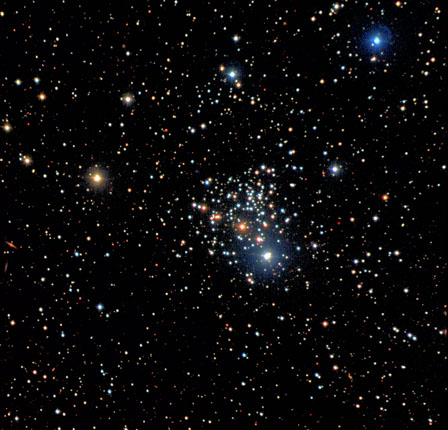

Open Cluster NGC 2266
| Date: | 27.10.1995
| Time: | 00:55 UT
| Exposure: | B:40m, V:45m, I:10m
|
| Field of View: | 19.2' x 18.5'
| Receiver: |
WWFPP,
20482 CCD
| Filter: | B, V, I
|
| Instrument: |
1.23m
| Observatory: |
Calar Alto
| Observer: | T. Credner, S. Kohle
|
© Copyright by the observers

Astronomical Institutes of the University of Bonn
From Colors to Astrophysics
This three color composite
is consisting of Johnson B, V, and
I filter exposures, represented in blue, green, and red respectively.
The Open Star Cluster NGC 2266 lies in a distance of about 3.4 kpc towards
the constellation Gemini.
Its apparent diameter is just about 5'.
It belongs to the population of old open star clusters in our galaxy, i.e. ages of one billion years
or even older (Phelps et al., 1994). In the above image you can see this fact at the
relative large number of red stars lying in the field of the cluster. Most blue stars
in the cluster are "normal" hydrogen core burning stars. But many stars already
left this evolutionary stage, because their central hydrogen is exhausted. Now they burn
their hydrogen in a shell around the stellar nucleus and do appear
as bright red giant stars. The brightest stars in the image are probably
foreground stars and do not belong to the cluster population.
On the left hand side you can recognize two small edge-on galaxies.
References:
1991AcA....41..191K, Kaluzny et al., The Hyades-age anticenter cluster NGC 2266
1994AJ....107.1079P, Phelps et al., Development of the Galactic Disk: A search for the oldest Open Clusters
SEDS infos
This image is already published in:
Astronomy
Picture of the Day, April 29, 1999,
NASA
